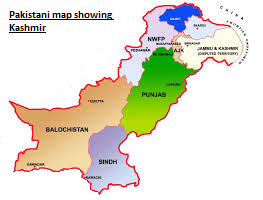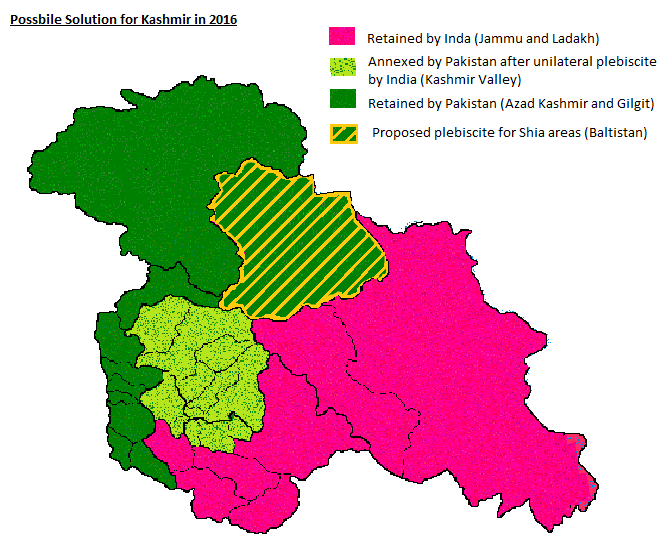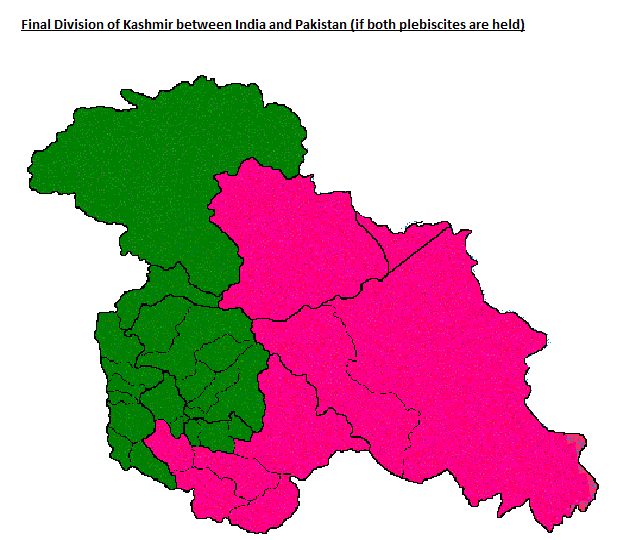CEDING THE TERRITORIAL IMPERATIVE

by
AJIT SARMA
________________________________________________________
All
creatures on earth are territorial in some way shape or form,
none more so than humans. Over our entire history, this impertive
has resulted in millions of needless deaths, destruction of
livelihoods and property, and a tragic repetition of this
cycle to avenge loss of territory or even worse, loss of pride.
In
rare instances, relinquishing a territory voluntarily may
just result in a lasting peace; then again it may not. Here
is a synopsis of the situation in Kashmir.
First
the history, then the fix.
In 1947 Kashmir had
a Hindu Raja and an 85% Muslim majority population. The Raja had
a choice to join India or Pakistan but dithered, dreaming of an
independent Himalayan Switzerland (1946-1947).
 Pakistan’s
leader Jinnah encouraged a Jihadist movement with Pashtun/Afghan/Khyber
tribes to liberate Kashmir’s Muslim brethren from the Hindu
Raja’s despotic rule, specifically after a massacre of Muslims
in Jammu in 1947. The Pakistani army secretly supplied arms to
internal Muslim revolts throughout Kashmir, hoping to force Kashmir’s
union with Pakistan.
Pakistan’s
leader Jinnah encouraged a Jihadist movement with Pashtun/Afghan/Khyber
tribes to liberate Kashmir’s Muslim brethren from the Hindu
Raja’s despotic rule, specifically after a massacre of Muslims
in Jammu in 1947. The Pakistani army secretly supplied arms to
internal Muslim revolts throughout Kashmir, hoping to force Kashmir’s
union with Pakistan.
With
half the state overrun, the Raja appealed to India for help to
fight the raiders. India agreed, on condition that the Raja legally
join (accede) his princely State to India, thus making Kashmir
part of India, which he did. However the veracity and date of
this document of accession has been disputed repeatedly by Pakistan
and the original has never been found.
India
airlifted troops to Kashmir to fight the raiders and began pushing
them back (October 1947). Regular Pakistan troops entered the
battle to support the raiders who were retreating (November 1947).
In early 1948, India lodged a complaint against Pakistan to the
newly formed United Nations (U.N.) in an attempt to declare Pakistan
as the aggressor. 
The Pakistani
Ambassador to the U.N., Sir Mohammed Zafrullah Khan (an Ahmaddiya
Muslim), made a brilliant presentation to the U.N. convincing
the Security Council and the five powers that the wishes of the
Kashmiri people were paramount and that they should be given a
choice to choose between India or Pakistan. The U.N. Security
Council agreed much to India chagrin and passed a resolution requiring
the armies of Pakistan to vacate territory of the State of Kashmir,
to be followed by a U.N. supervised plebiscite for the Kashmiri
people to choose between joining India or Pakistan. It also contained
a provision to maintain Indian civilian control to maintain law
and order, and to allow the plebiscite to be held. By the provisions
of the India Independence Act that was passed in the U.K. parliament
in 1947, there was no provision for Kashmiri independence.
In January
1949, the UN established the current cease fire line partitioning
Kashmir into two parts (Pakistan administered Kashmir and Indian
administered Kashmir) after a year of war between the two countries.
In India,
Nehru has always been blamed for taking the case to the UN when
the Indian army had the Pakistani army on the run in December
1948. Fearing a loss of control and a loss of the plebiscite vote,
Pakistani troops never left. Using this as an excuse, India has
consistently refused to hold the plebiscite.
In 1965
Pakistan started a war to liberate Kashmir, but the expected pro-Pakistan
Muslim uprising never happened. The war ended in a stalemate.
In 1971
India supported the secessionist movement in East Pakistan (soon
to be Bangladesh) which meant sheltering approximately ten million
Hindu refugees who were fleeing massacres and persecution by the
Pakistani Army. Approximately two million Bangladeshi intellectuals
(mostly Muslim) were also killed by the Pakistani Army in 1971.
Bangladesh
became independent in 1972. Since then, Pakistan has made it primary
goal to strip India of Kashmir in a quid pro quo.
In 1973,
all Ahmaddiyas were labelled as heretics in the new Islamic Pakistani
constitution and were henceforth classified as a non-Muslim community
and stripped of their rights. This allowed the majority Sunnis
in Pakistan to systematically oppress all non-orthodox Muslims
including the 20% Shia minority scattered throughout Pakistan.
Beginning
in 1980, with the Russian occupation of Afghanistan, the aid and
arms given to Pakistan to fight Russia were for a significant
part sent to Indian Kashmir to foment trouble resulting in India
pouring in 500,000 – 800,000 troops to control the Kashmir
Valley (pop. 6,800,000). As is wont to happen in military occupations,
the army made a mess, interned people without legal warrant, killed
others indiscriminately, raped women, (indisputable facts that
continue to be denied by most Indians) resulting in the entire
population turning against India.
Meanwhile
US arms (to fight the Russians, and later the Taliban after 9/11)
were still being funnelled into Indian Kashmir; the supply continues
unfettered to this day.
 India’s attempts to have agencies Lakshar-Taiba, Jaish-e-Mohammed,
Hizb-ul-Ujahideen declared as terrorist organizations have been
stymied until recently by the USA and China (Pakistan’s
allies). So today, the 1949 U.N. cease fire line, renamed in 1971
as the Line of Control, still, divides Kashmir into two parts.
India’s attempts to have agencies Lakshar-Taiba, Jaish-e-Mohammed,
Hizb-ul-Ujahideen declared as terrorist organizations have been
stymied until recently by the USA and China (Pakistan’s
allies). So today, the 1949 U.N. cease fire line, renamed in 1971
as the Line of Control, still, divides Kashmir into two parts.
Both
countries claim Kashmir in its entirety but cannot go to war because
of the threat of nuclear retaliation. The restive Muslim population
of 6,800,000 in the Kashmir valley does ‘not’ want
to be part of India.
The Hindu
(Jammu) and Buddhist (Ladakh), parts of Kashmir both want to stay
in India. They have a 30% and 40% Muslim minority population respectively.
All Hindus
and Buddhists were forced to flee the areas of Kashmir occupied
by Pakistan in 1949. Approximately 300,000 Hindus were expelled
from the Kashmir Valley beginning in 1989 in an ethnic cleansing
operation by the valley’s Muslims even though it was under
Indian control. The Hindu and Buddhist presence in the Kashmir
valley predates the advent of Islam in 1300 CE in this area by
nearly 2000 years. Kashmir had been a major Buddhist center of
learning along with parts of Afghanistan (see Bahmian Buddha).
SOLUTION
ON THE GROUND
In 2016,
it is pointless for India to try and convince the 6.8 million
Muslims that India is their champion. There is no goodwill left
for this to happen. India must have a supervised plebiscite in
the Kashmir Valley, and if needed in Jammu and Ladakh –
the three areas currently  being
administered by India.
being
administered by India.
If a
plebiscite were to be held, the Kashmir valley will vote to join
Pakistan, and  Jammu
and Ladakh will vote to remain in India. In respect to the latter
two, of course Pakistan will not recognize the results and will
continue to covet the territory of the non-Muslim parts of state.
This is somewhat akin to Yasser Arafat’s PLO and today’s
Mahmoud Abbas wanting all of Israel to be part of the PLO’s
Palestinian state!
Jammu
and Ladakh will vote to remain in India. In respect to the latter
two, of course Pakistan will not recognize the results and will
continue to covet the territory of the non-Muslim parts of state.
This is somewhat akin to Yasser Arafat’s PLO and today’s
Mahmoud Abbas wanting all of Israel to be part of the PLO’s
Palestinian state!
But by
doing this, India, however belatedly, will have held the much
vaunted U.N. plebiscite, which will legally oblige it to cede
the most valuable part of K(c)a$hmir (equivalent of Jerusalem
if you will), but in the spirit of democracy and human rights
it will be able to declare to the world that the people of Kashmir
have made their choice, and that India will re-draw the border
accordingly.
Finally,
this brave and unprecedented granting of independence (willingly
ceding territory for a higher cause) will appease nearly seven
million Muslims in Kashmir, now reunited with their Muslim brethren
in Pakistan, and hopefully the malcontent terrorists among them,
presently funded by Pakistan, Saudi Arabia, Qatar and the UAE.
Once
this agreement becomes fact, and the two Muslim entities are reunited;
only time will tell if Kashmir’s Muslims will want to become
independent from Pakistan.
Addendum:
There is one area of Pakistan administered Kashmir, the region
known as Baltistan at the foot of K2, the second highest mountain
in the world. It is predominantly (90%) Shia and the people
speak Balti, a Tibetan based language similar to Ladakhi. Baltistan
was severed by the 1949 line from the Buddhist kingdom of Ladakh.
Pakistan
has been trying to dilute the 90% Shia majority in this region
by encouraging Sunni immigration. This undeclared policy has
already resulted in thousands of deaths of the indigenous population
due to the Sunni religious intolerance of Shias.
If
Pakistan truly professes its desire to champion the Kashmiri
people’s cause for a choice between the two countries,
a plebiscite held this region would most likely result in a
vote to join India, even though they are Muslim.
Final
thought: If both sides lift the veil of darkness, they will
realize that with this solution the Muslim Sunnis in Kashmir
will live in an Islamic Pakistan, the Shias and the non Muslim
people (the Buddhists, Sikhs, Hindus) in a secular India. There
will be no majority repressing any minority. Lastly, the will
of the 'people of Kashmir' will be heard and recognized under
international law. All Kashmiris will have finally the opportunity
to live in peace on their ancestral lands.
COMMENTS
user-submission@feedback.com
Thank you Ajit Sarma. I am a Muslim and I thank you for reaching
out.
user-submission@feedback.com
I commend the clarity of this article but disagree with blame
assigned to India. Where we are now and not where we were is
where we must begin on the rocky road to solutions.
Arts
& Opinion, a bi-monthly, is archived in the
Library and Archives Canada.
ISSN 1718-2034